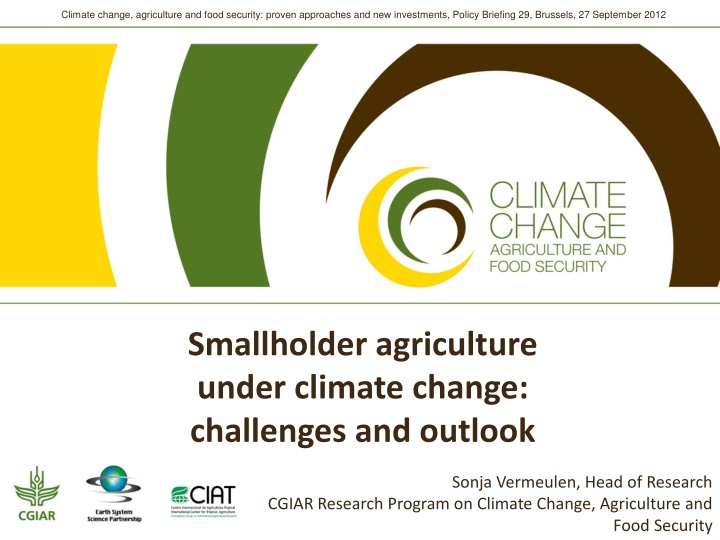
Addressing Climate Change Impacts on Agriculture and Food Security
Explore the challenges and outlook for smallholder agriculture under climate change, with a focus on the impacts of a potential 4-degree rise by 2100. Understand the long-term trends, increasing extreme weather events, major ecosystem transitions, and risks to the poorest populations. Learn about becoming climate-smart and the importance of adaptive capacity.
Download Presentation

Please find below an Image/Link to download the presentation.
The content on the website is provided AS IS for your information and personal use only. It may not be sold, licensed, or shared on other websites without obtaining consent from the author. If you encounter any issues during the download, it is possible that the publisher has removed the file from their server.
You are allowed to download the files provided on this website for personal or commercial use, subject to the condition that they are used lawfully. All files are the property of their respective owners.
The content on the website is provided AS IS for your information and personal use only. It may not be sold, licensed, or shared on other websites without obtaining consent from the author.
E N D
Presentation Transcript
Climate change, agriculture and food security: proven approaches and new investments, Policy Briefing 29, Brussels, 27 September 2012 Smallholder agriculture under climate change: challenges and outlook Sonja Vermeulen, Head of Research CGIAR Research Program on Climate Change, Agriculture and Food Security
Impacts 1: Long-term trends in temperature and rainfall Length of growing period (%) >20% loss 5-20% loss No change 5-20% gain >20% gain To 2090, taking 14 climate models Four degree rise Thornton et al. 2010
Impacts 2: Increasing frequency and intensity of extreme weather events Pulwaty 2010
Impacts 3: Major transitions in ecosystems and livelihoods 2050 compared with 2005 in A1B scenario Cheung et al 2010
Impacts 4: Poorest at risk By 2050, severe childhood stunting up by 23% in central Africa and 62% in South Asia (uses IFPRI IMPACT model + socio-economic models) Lloyd et al. 2011 Environmental Health Perspectives
Becoming climate smart
GHG CO2-eq tonne per capita Food security 25 20 15 10 5 0 US Malawi Ecological footprint Adaptation Climate-smart agriculture means building resilience, balancing trade-offs, suiting the context
Adaptive capacity Technology Income & assets Infrastructure Knowledge & skills Governance & institutions Access to information Social capital
Key adaptation strategies Incremental adaptation to progressive climate change Closing yield gaps (i.e. sustainable intensification) Raising the bar technologies & policies for 2030s Climate risk management Technologies (e.g. flood control) Institutions (e.g. index-based insurance) Climate information systems (e.g. seasonal forecasts) Transformative adaptation Changing production systems Changing livelihood portfolios
Adapting to long-term climate trends Example: Climate analogue tool Identifies the range of places whose current climates correspond to the future of a chosen locality These sites are used for cross-site farmer visits, & participatory crop & livestock trials
Example: Climate services Met services produce forecast information downscaled in space & time Farmers & met services work together to ensure forecasts meet local needs Adapting to greater climate variability
To transformational adaptation? Relocation of growing areas & processing facilities Agricultural diversification, or shifts Livelihood diversification, or shifts Migration
Climate change impacts on smallholder agriculture: Are more complex than often assumed and happening faster than often assumed Are unevenly distributed geographically Depend on household and national capacities and contexts as well as on exposure to climate threats Pose major threats to nutrition, welfare, incomes and health among poorer households
Responding with climate-smart agriculture: Is foremost about development addressing smallholder concerns, building assets & resilience Adds new actions on climate to sustainable development Deals with trade-offs, not only win-win-wins Must be landscape-smart too Will not solve future food security on its own (need actions on distribution, diets, waste)
www.ccafs.cgiar.org sign up for news on agriculture & climate change follow us on twitter @cgiarclimate
